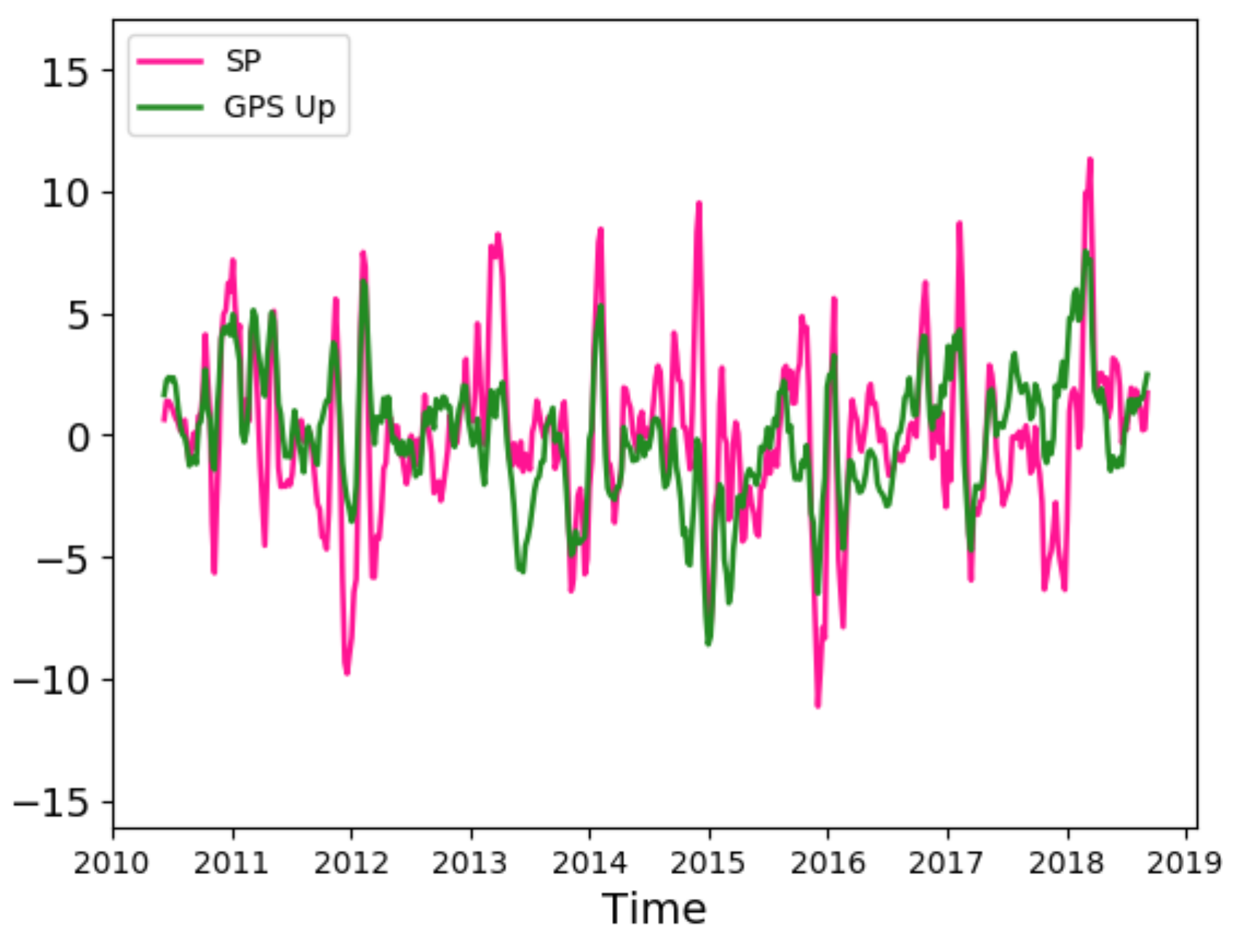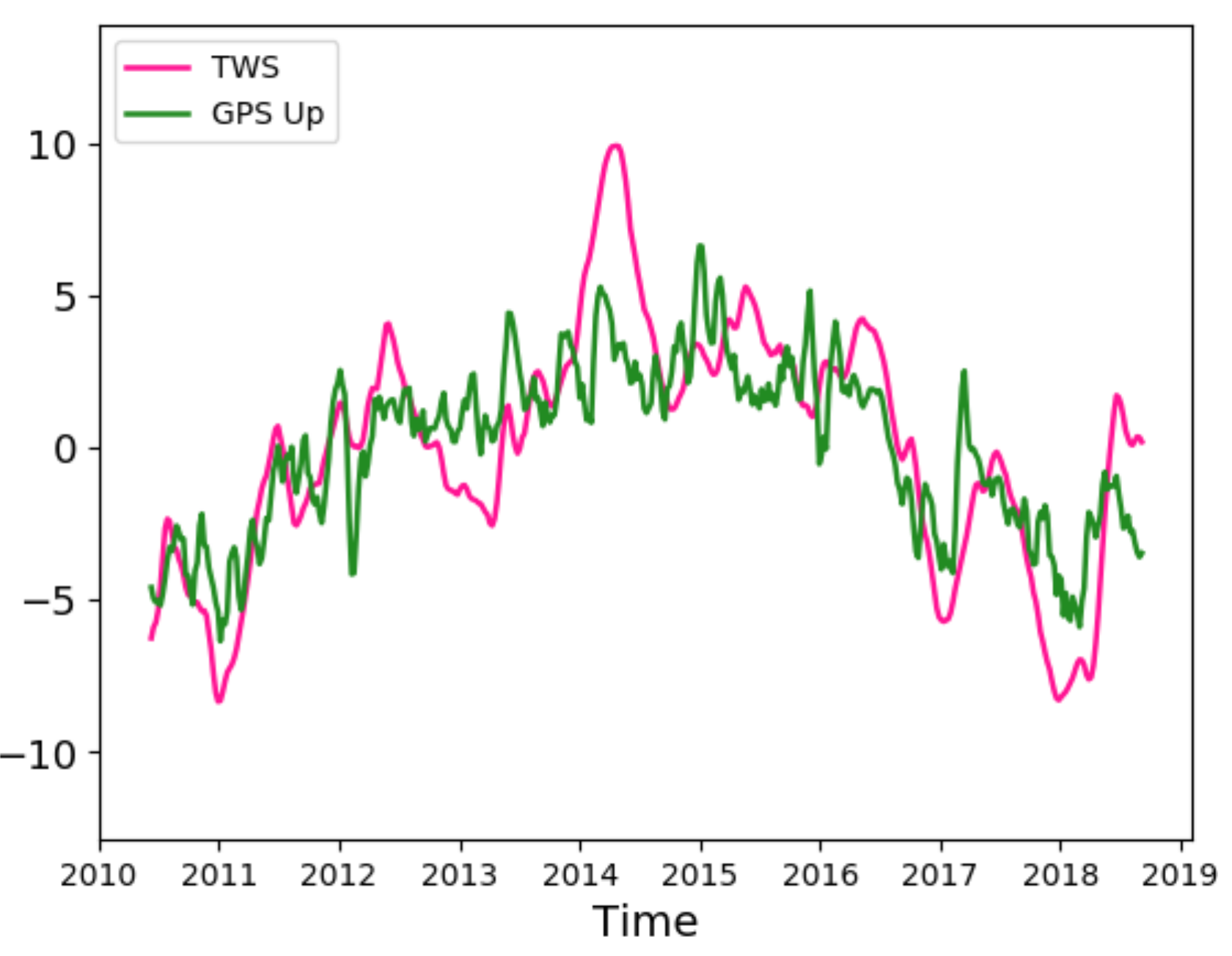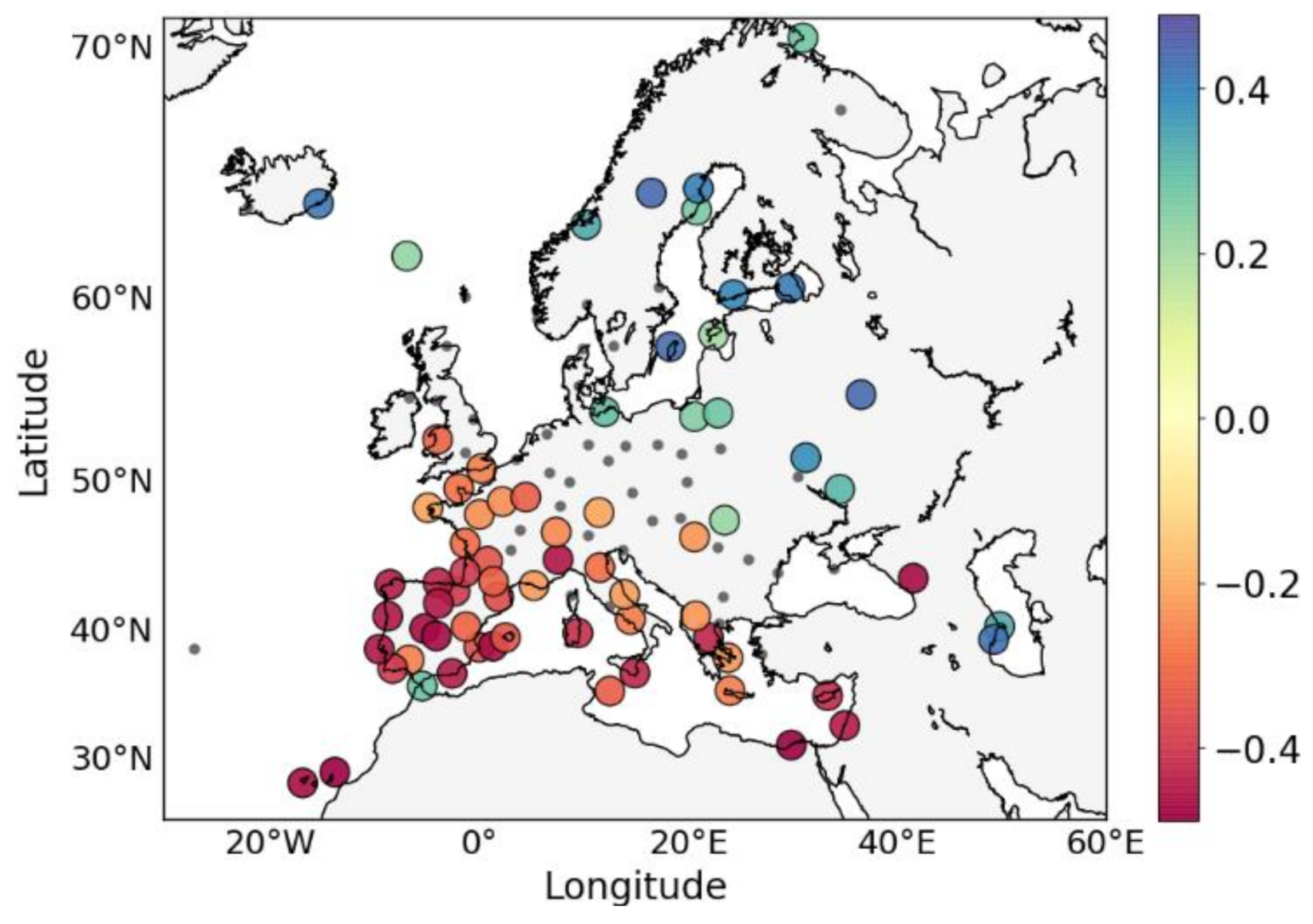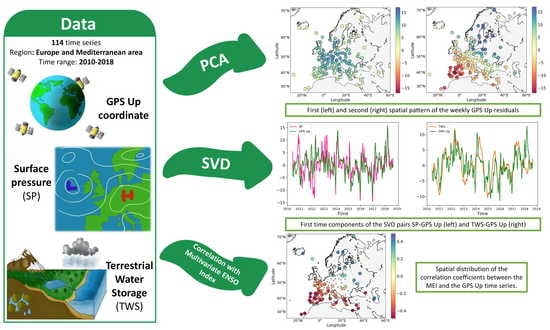Interannual Variability of GPS Heights and Environmental Parameters over Europe and the Mediterranean Area
Abstract
1. Introduction
2. Materials and Methods
2.1. GPS Up Time Series
2.2. Atmospheric Pressure Time Series
2.3. Terrestrial Water Storage Time Series
2.4. Climate Indexes
2.5. PCA and SVD Methodologies
3. Results of the PCA Analysis
3.1. Spatial Patterns and Time Components of the GPS Up Residuals
3.2. Spatial Patterns and Time Components of the SP Residuals
3.3. Spatial Patterns and Time Components of the TWS Residuals
4. Results of the SVD Analysis
4.1. Spatial Patterns and Time Components of the Residuals of the Up–SP Pair
4.2. Spatial Patterns and Time Components of the Residuals of the Up–TWS Pair
5. GPS Up and Climate Indexes
6. Discussion
6.1. Interannual Vertical Deformations and Variations of SP and TWS
6.2. MEI and Vertical Deformations
7. Conclusions
Author Contributions
Funding
Institutional Review Board Statement
Informed Consent Statement
Data Availability Statement
Acknowledgments
Conflicts of Interest
References
- Teixell, A.; Bertotti, G.; Frizon de Lamotte, D.; Charroud, M. The geology of vertical movements of the lithosphere: An overview. Tectonophysics 2009, 475, 1–8. [Google Scholar] [CrossRef]
- Blewitt, G.; Lavallée, D.; Clarke, P.; Nurutdinov, K. A New Global Mode of Earth Deformation: Seasonal Cycle Detected. Science 2001, 294, 2342–2345. [Google Scholar] [CrossRef] [PubMed]
- Blewitt, G.; Lavallée, D. Effect of annual signals on geodetic velocity. J. Geophys. Res. Solid Earth 2002, 107, ETG 9-1–ETG 9-11. [Google Scholar] [CrossRef]
- Blewitt, G.; Lavallée, D. Correction to “Effect of annual signals on geodetic velocity” by Geoffrey Blewitt and David Lavallée. J. Geophys. Res. Solid Earth 2003, 108, ETG 4-1. [Google Scholar] [CrossRef]
- Farrell, W.E. Deformation of the Earth by surface loads. Rev. Geophys. 1972, 10, 761–797. [Google Scholar] [CrossRef]
- Van Dam, T.M.; Wahr, J. Modeling environment loading effects: A review. Phys. Chem. Earth 1998, 23, 1077–1087. [Google Scholar] [CrossRef]
- Gegout, P.; Boy, J.-P.; Hinderer, J.; Ferhat, G. Modeling and Observation of Loading Contribution to Time-Variable GPS Sites Positions. In Gravity, Geoid and Earth Observation; Mertikas, S., Ed.; Springer: Berlin/Heidelberg, Germany, 2010; Volume 135, pp. 651–659. [Google Scholar] [CrossRef]
- Petrov, L.; Boy, J.-P. Study of the atmospheric pressure loading signal in very long baseline interferometry observations. J. Geophys. Res. Solid Earth 2004, 109, B03405. [Google Scholar] [CrossRef]
- Tregoning, P.; Van Dam, T.M. Atmospheric pressure loading corrections applied to GPS data at the observation level. Geophys. Res. Lett. 2005, 32, L22310. [Google Scholar] [CrossRef]
- Girotto, M.; Rodell, M. Chapter Two—Terrestrial water storage. In Extreme Hydroclimatic Events and Multivariate Hazards in a Changing Environment; Maggioni, V., Massari, C., Eds.; Elsevier: Amsterdam, The Netherlands, 2019; pp. 41–64. [Google Scholar] [CrossRef]
- Van Dam, T.; Lavallée, D.; Wahr, J.; Milly, C.D.; Shmakin, A.B.; Blewitt, G.; Larson, K.M. Crustal displacements due to continental water loading. Geophys. Res. Lett. 2001, 28, 651–654. [Google Scholar] [CrossRef]
- Subirana, J.S.; Zornoza, J.M.J.; Hernández-Pajares, M. Earth Deformation Effects Modelling. In GNSS Data Processing, Vol. I: Fundamentals and Algorithms; Fletcher, K., Ed.; ESA Communications ESTEC: Noordwijk, The Netherlands, 2013; Volume 1, pp. 134–137. ISSN 1013-7076. Available online: https://gssc.esa.int/navipedia/GNSS_Book/ESA_GNSS-Book_TM-23_Vol_I.pdf (accessed on 28 October 2020).
- Zerbini, S.; Matonti, F.; Raicich, F.; Richter, B.; van Dam, T. Observing and assessing nontidal ocean loading using ocean, continuous GPS and gravity data in the Adriatic area. Geophys. Res. Lett. 2004, 31, L23609. [Google Scholar] [CrossRef]
- van Dam, T.; Collilieux, X.; Wuite, J.; Altamimi, Z.; Ray, J. Nontidal ocean loading: Amplitudes and potential effects in GPS height time series. J. Geod. 2012, 86, 1043–1057. [Google Scholar] [CrossRef]
- Mémin, A.; Boy, J.-P.; Santamaría-Gómez, A. Correcting GPS measurements for non-tidal loading. GPS Solut. 2020, 24, 45. [Google Scholar] [CrossRef]
- Wu, S.; Nie, G.; Meng, X.; Liu, J.; He, Y.; Xue, C.; Li, H. Comparative Analysis of the Effect of the Loading Series from GFZ and EOST on Long-Term GPS Height Time Series. Remote Sens. 2020, 12, 2822. [Google Scholar] [CrossRef]
- Kaczmarek, A. Influence of Geophysical signals on coordinate variations GNSS permanent stations in central Europe. Artif. Satell. 2019, 54, 57–71. [Google Scholar] [CrossRef]
- Li, Z.; Chen, W.; van Dam, T.; Reibischung, P.; Altamimi, Z. Comparative analysis of different atmospheric surface pressure models and their impacts on daily ITRF2014 GNSS residual time series. J. Geod. 2020, 94, 42. [Google Scholar] [CrossRef]
- Ostanciaux, E.; Husson, L.; Choblet, G.; Robin, C.; Pedoja, K. Present-day trends of vertical ground motion along the coast lines. Earth Sci. Rev. 2012, 110, 74–92. [Google Scholar] [CrossRef]
- Springer, A.; Karegar, M.A.; Kusche, J.; Keune, J.; Kurtz, W.; Kollet, S. Evidence of daily hydrological loading in GPS time series over Europe. J. Geod. 2019, 93, 2145–2153. [Google Scholar] [CrossRef]
- Tiwari, V.M.; Srinivas, N.; Singh, B. Hydrological changes and vertical crustal deformation in south India: Inference from GRACE, GPS and absolute gravity data. Phys. Earth Planet. Int. 2014, 231, 74–80. [Google Scholar] [CrossRef]
- Jin, S.; Zhang, T. Terrestrial Water Storage Anomalies Associated with Drought in Southwestern USA from GPS Observations. Surv. Geophys. 2016, 37, 1139–1156. [Google Scholar] [CrossRef]
- Adusumilli, S.; Borsa, A.A.; Fish, M.A.; McMillan, H.K.; Silverii, F. A decade of Water Storage Changes across the Contiguous United States from GPS and Satellite Gravity. Geophys. Res. Lett. 2019, 46, 13006–13015. [Google Scholar] [CrossRef]
- Compton, K.; Bennett, R.A.; Hreinsdóttir, S. Climate-driven vertical acceleration of Icelandic crust measured by continuous GPS geodesy. Geophys. Res. Lett. 2015, 42, 743–750. [Google Scholar] [CrossRef]
- Zerbini, S.; Raicich, F.; Errico, M.; Cappello, G. An EOF and SVD analysis of interannual variability of GPS coordinates, environmental parameters and space gravity data. J. Geodyn. 2013, 67, 111–124. [Google Scholar] [CrossRef]
- Blewitt, G.; Hammond, W.C.; Kreemer, C. Harnessing the GPS Data Explosion for Interdisciplinary Science. Eos 2018, 99. [Google Scholar] [CrossRef]
- SOPAC. The Scripps Orbit and Permanent Array Center. Available online: http://sopac.ucsd.edu/ (accessed on 18 June 2020).
- Bruni, S.; Zerbini, S.; Raicich, F.; Errico, M.; Santi, E. Detecting discontinuities in GNSS coordinate time series with STARS: Case study, the Bologna and Medicina GPS sites. J. Geod. 2014, 88, 1203–1214. [Google Scholar] [CrossRef]
- Kalnay, E.; Kanamitsu, M.; Kistler, R.; Collins, W.; Deaven, D.; Gandin, L.; Iredell, M.; Saha, S.; White, G.; Woollen, J.; et al. The NCEP/NCAR 40-year reanalysis project. Bull. Amer. Meteor. Soc. 1996, 77, 437–470. [Google Scholar] [CrossRef]
- Global Modeling and Assimilation Office (GMAO). MERRA-2 tavg1_2d_lnd_Nx: 2d,1-Hourly, Time-Averaged, Single-Level, Assimilation, Land Surface Diagnostics V5.12.4, Greenbelt, MD, USA, Goddard Earth Sciences Data and Information Services Center (GES DISC), 2015. Available online: https://arcticdata.io/catalog/view/doi%3A10.18739%2FA27M0416J (accessed on 30 September 2020). [CrossRef]
- Jolliffe, I.T.; Cadima, J. Principal component analysis: A review and recent developments. Phil. Trans. R. Soc. A 2016, 374, 20150202. [Google Scholar] [CrossRef]
- Papoulis, A. A new algorithm in spectral analysis and band-limited extrapolation. IEEE Trans. Circuits Syst. 1975, 22, 735–742. [Google Scholar] [CrossRef]
- Gerchberg, R. Super-resolution through error energy reduction. Opt. Acta 1974, 21, 709–720. [Google Scholar] [CrossRef]
- Roweis, S. EM algorithms for PCA and SPCA. In Advances in Neural Information Processing Systems; MIT Press: Cambridge, MA, USA, 1998; Volume 10, pp. 626–632. [Google Scholar]
- Björnsson, H.; Venegas, S. A Manual for EOF and SVD Analyses of Climatic Data. McGill Univ. Rep. N 1997, 97, 112–134. Available online: http://www.geog.mcgill.ca/gec3/wp-content/uploads/2009/03/Report-no.-1997-1.pdf (accessed on 4 May 2020).
- GCOS. Available online: https://gcos.wmo.int/en/essential-climate-variables (accessed on 22 January 2020).
- WMO. Statement on the State of the Global Climate in 2011; World Meteorological Organization: Geneva, Switzerland, 2012; No 1085; p. 19. ISBN 978-92-63-11085-5. Available online: https://library.wmo.int/index.php?lvl=notice_display&id=9754#.YBLB9-hKhjk (accessed on 14 January 2021).
- Bissolli, P.; Ziese, M.; Pietzsch, S.; Finger, P.; Friedrich, K.; Nitsche, H.; Obregón, A. Drought conditions in Europe in the spring of 2012. Dtsch. Wetterd. 2012. Available online: https://www.dwd.de/EN/ourservices/specialevents/drought/20120810_Trockenheit_2012_en.pdf?_blob=publicationFile&v=4 (accessed on 13 January 2021).
- WMO. Statement on the State of the Global Climate in 2013; World Meteorological Organization: Geneva, Switzerland, 2014; No 1130; Volume 21, ISBN 978-92-63-11130-2. Available online: https://library.wmo.int/index.php?lvl=notice_display&id=15957#.YBLBq-hKhjk (accessed on 14 January 2021).
- WMO. Statement on the State of the Global Climate in 2014; World Meteorological Organization: Geneva, Switzerland, 2015; No 1152; Volume 19, ISBN 978-92-63-11152-4. Available online: https://library.wmo.int/index.php?lvl=notice_display&id=16898#.YBLVeehKhjk (accessed on 14 January 2021).
- WMO. Statement on the State of the Global Climate in 2015; World Meteorological Organization: Geneva, Switzerland, 2016; No 1167; Volume 23, ISBN 978-92-63-11167-8. Available online: https://library.wmo.int/index.php?lvl=notice_display&id=19125#.YBLDkOhKhjk (accessed on 14 January 2021).
- Ionita, M.; Tallaksen, L.M.; Kingstone, D.G.; Stagge, J.H.; Laaha, G.; Van Lanen, H.A.J.; Scholz, P.; Chelcea, S.M.; Haslinger, K. The European 2015 drought from a climatological perspective. Hydrol. Earth Syst. Sci. 2017, 21, 1397–1419. [Google Scholar] [CrossRef]
- García-Herrera, R.; Garrido-Perez, J.M.; Barriopedro, D.; Ordóñez, C.; Vicente-Serrano, S.M.; Nieto, R.; Gimeno, L.; Sorí, R.; Yiou, P. The European 2016/17 Drought. J. Clim. 2019, 32, 3169–3187. [Google Scholar] [CrossRef]
- WMO. Statement on the State of the Global Climate in 2017; World Meteorological Organization: Geneva, Switzerland, 2018; No 1212; Volume 35, ISBN 978-92-63-11212-5. Available online: https://library.wmo.int/index.php?lvl=notice_display&id=20220#.YBLgL-hKhjk (accessed on 15 January 2021).
- Copernicus. Climate in 2017—European Wet and Dry Indicators. Available online: https://climate.copernicus.eu/climate-2017-european-wet-and-dry-indicators (accessed on 11 February 2021).
- WMO. Statement on the State of the Global Climate in 2018; World Meteorological Organization: Geneva, Switzerland, 2019; No 1233; Volume 39, ISBN 978-92-63-11233-0. Available online: https://library.wmo.int/index.php?lvl=notice_display&id=20799#.YBPg5-hKhjk (accessed on 15 January 2021).
- King, M.P.; Yu, E.; Sillmann, J. Impact of strong and extreme El Niños on European hydroclimate. Tellus A 2020, 72, 1–10. [Google Scholar] [CrossRef]
- Brönnimann, S.; Xoplaki, E.; Casty, C.; Pauling, A.; Luterbacher, J. ENSO influence on Europe during the last centuries. Clim. Dyn. 2007, 28, 181–197. [Google Scholar] [CrossRef]
- Roesli, H.-P. A Westward Travelling ULL Induced the Rapid Reversal of a Pressure Gradient across the Alpine Range in Mid-March 2016. Last Updated 4 November 2020. Available online: http://eumetsat.int/upper-level-low-ull-over-northern-europe (accessed on 12 February 2021).
- WMO. Statement on the State of the Global Climate in 2010; World Meteorological Organization: Geneva, Switzerland, 2011; No 1074; Volume 15, ISBN 978-92-63-11074-9. Available online: https://library.wmo.int/doc_num.php?explnum_id=7739 (accessed on 22 January 2021).
- WMO. Statement on the State of the Global Climate in 2012; World Meteorological Organization: Geneva, Switzerland, 2013; No 1108; p. 33. ISBN 978-92-63-11108-1. Available online: https://library.wmo.int/index.php?lvl=notice_display&id=14750#.YBP0s-hKhjk (accessed on 15 January 2021).
- WMO. Statement on the State of the Global Climate in 2016; World Meteorological Organization: Geneva, Switzerland, 2017; No 1189; Volume 23, ISBN 978-92-63-11189-0. Available online: https://library.wmo.int/index.php?lvl=notice_display&id=19835#.YBP9VOhKhjk (accessed on 15 January 2021).
- van Dam, T.M.; Blewitt, G.; Heflin, M.B. Atmospheric pressure loading effects on Global Positioning System coordinate determinations. J. Geophys. Res. 1994, 99, 23939–23950. [Google Scholar] [CrossRef]
- Kreemer, C.; Blewitt, G. Robust estimation of spatially varying common-mode components in GPS time-series. J. Geod. 2021, 95, 13. [Google Scholar] [CrossRef]
- Wouter, P.; Bastos, A.; Ciais, P.; Vermeulen, A. A Historical, geographical and ecological perspective on the 2018 summer drought. Phil. Trans. R. Soc. B 2020, 375, 20190505. [Google Scholar] [CrossRef]
- Shaman, J.; Tziperman, E. An Atmospheric Teleconnection Linking ENSO and Southwestrn European Precipitation. J. Clim. 2011, 24, 124–139. [Google Scholar] [CrossRef]
- Tian, Y.; Shen, Z.-K. Extracting the regional common-mode component O GPS station position time series from dense continuous network. J. Geophys. Res. Solid Earth 2016, 121, 1080–1096. [Google Scholar] [CrossRef]
- Pan, Y.; Chen, R.; Ding, H.; Xu, X.; Zheng, G.; Shen, W.; Xiao, I. Common Mode Component and Its Potential Effect on GPS-Inferred Three-Dimensional Crustal Deformations in the Eastern Tibetan Plateau. Remote Sens. 2019, 11, 1975. [Google Scholar] [CrossRef]
- Mariotti, A.; Zeng, N.; Lau, K.-M. Euro Mediterranean rainfall and ENSO—A seasonally varying relationship. Geophys. Res. Lett. 2002, 29, 1621. [Google Scholar] [CrossRef]
- Cheng, M.; Ries, J.C. Decadal variation in Earth’s oblateness (J2) from satellite laser ranging data. Geophys. J. Int. 2018, 212, 1218–1224. [Google Scholar] [CrossRef]
- Chao, B.F.; Yu, Y.; Chung, C.H. Variation of Earth’s Oblateness J2 on Interannual-to-Decadal Timescales. J. Geophys. Res. Solid Earth 2020, 125, e2020JB019421. [Google Scholar] [CrossRef]


















| Modes | Variance (%) |
|---|---|
| 1 | 32.77 |
| 2 | 11.55 |
| 3 | 5.58 |
| 4 | 4.13 |
| Modes | Variance (%) |
|---|---|
| 1 | 46.54 |
| 2 | 22.22 |
| 3 | 11.82 |
| 4 | 5.64 |
| Modes | Variance (%) |
|---|---|
| 1 | 29.67 |
| 2 | 12.08 |
| 3 | 10.39 |
| 4 | 7.78 |
| Modes | Squared Covariance (%) |
|---|---|
| 1 | 52.03 |
| 2 | 19.43 |
| 3 | 8.70 |
| 4 | 4.33 |
| Modes | Squared Covariance (%) |
|---|---|
| 1 | 20.20 |
| 2 | 14.98 |
| 3 | 9.35 |
| 4 | 6.30 |
Publisher’s Note: MDPI stays neutral with regard to jurisdictional claims in published maps and institutional affiliations. |
© 2021 by the authors. Licensee MDPI, Basel, Switzerland. This article is an open access article distributed under the terms and conditions of the Creative Commons Attribution (CC BY) license (https://creativecommons.org/licenses/by/4.0/).
Share and Cite
Elia, L.; Zerbini, S.; Raicich, F. Interannual Variability of GPS Heights and Environmental Parameters over Europe and the Mediterranean Area. Remote Sens. 2021, 13, 1554. https://doi.org/10.3390/rs13081554
Elia L, Zerbini S, Raicich F. Interannual Variability of GPS Heights and Environmental Parameters over Europe and the Mediterranean Area. Remote Sensing. 2021; 13(8):1554. https://doi.org/10.3390/rs13081554
Chicago/Turabian StyleElia, Letizia, Susanna Zerbini, and Fabio Raicich. 2021. "Interannual Variability of GPS Heights and Environmental Parameters over Europe and the Mediterranean Area" Remote Sensing 13, no. 8: 1554. https://doi.org/10.3390/rs13081554
APA StyleElia, L., Zerbini, S., & Raicich, F. (2021). Interannual Variability of GPS Heights and Environmental Parameters over Europe and the Mediterranean Area. Remote Sensing, 13(8), 1554. https://doi.org/10.3390/rs13081554






